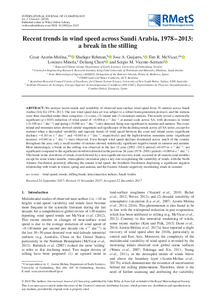Por favor, use este identificador para citar o enlazar este ítem:
http://hdl.handle.net/20.500.11765/8395
Recent trends in wind speed across Saudi Arabia, 1978–2013: a break in the stilling
| Título : | Recent trends in wind speed across Saudi Arabia, 1978–2013: a break in the stilling |
| Autor : | Azorín Molina, César; Rehman, Shafiqur; Guijarro Pastor, José Antonio


|
| Palabras clave : | Wind speed; Trends; Stilling break; Teleconnection indices |
| Fecha de publicación : | 2018 |
| Editor: | Royal Meteorological Society; Wiley |
| Citación : | International Journal of Climatology. 2018, 38(S1), p. e966-e984 |
| Versión del editor: | https://dx.doi.org/10.1002/joc.5423 |
| Resumen : | We analyse recent trends and variability of observed near-surface wind speed from 19 stations across Saudi Arabia (SA) for 1978–2013. The raw wind speed data set was subject to a robust homogenization protocol, and the stations were then classified under three categories: (1) coast, (2) inland and (3) mountain stations. The results reveal a statistically significant ( p < 0.05) reduction of wind speed of − 0.058 m s − 1 dec − 1 at annual scale across SA, with decreases in winter ( − 0.100 m s − 1 dec − 1 ) and spring ( − 0.066 m s − 1 dec − 1 ) also detected, being non-significant in summer and autumn. The coast, inland and mountain series showed similar magnitude and significance of the declining trends across all SA series, except for summer when a decoupled variability and opposite trends of wind speed between the coast and inland series (significant declines: − 0.101 m s − 1 dec − 1 and − 0.065 m s − 1 dec − 1 , respectively) and the high-elevation mountain series (significant increase: + 0.041 m s − 1 dec − 1 ) were observed. Even though wind speed declines dominated across much of the country throughout the year, only a small number of stations showed statistically significant negative trends in summer and autumn. Most interestingly, a break in the stilling was observed in the last 12-year (2002–2013) period ( + 0.057 m s − 1 dec − 1 ; not significant) compared to the significant slowdown detected in the previous 24-year (1978–2001) period ( − 0.089 m s − 1 dec − 1 ). This break in the slowdown of winds, even followed by a non-significant recovery trend, occurred in all seasons (and months) except for some winter months. Atmospheric circulation plays a key role in explaining the variability of winds, with the North Atlantic Oscillation positively affecting the annual wind speed, the Southern Oscillation displaying a significant negative relationship with winds in winter, spring and autumn, and the Eastern Atlantic negatively modulating winds in summer. |
| Patrocinador: | C. A-M. has received funding from the European Union’s Horizon 2020 research and innovation programme under the Marie Skłodowska-Curie grant agreement no. 703733 (STILLING project). This research was supported by the research projects: Swedish BECC, MERGE, VR (2014-5320). |
| URI : | http://hdl.handle.net/20.500.11765/8395 |
| ISSN : | 0899-8418 1097-0088 |
| Colecciones: | Artículos científicos 2015-2018 |
Ficheros en este ítem:
| Fichero | Descripción | Tamaño | Formato | ||
|---|---|---|---|---|---|
| Azorin-Molina_et_al-2... | 12,86 MB | Adobe PDF |  Visualizar/Abrir |
Los ítems de Arcimis están protegidos por una Licencia Creative Commons, salvo que se indique lo contrario.





